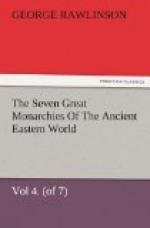The Chaldee astrology was, primarily and mainly, genethlialogical. It inquired under what aspect of the heavens persons were born, or conceived, and, from the position of the celestial bodies at one or other of these moments, it professed to deduce the whole life and fortunes of the individual. According to Diodorus, it was believed that a particular star or constellation presided over the birth of each person, and thenceforward exercised over his life a special malign or benignant influence. But his lot depended, not on this star alone, but on the entire aspect of the heavens at a certain moment. To cast the horoscope was to reproduce this aspect, and then to read by means of it the individual’s future.
Chaldee astrology, was not, however, limited to genethlialogy. The Chaldaeans professed to predict from the stars such things as the changes of the weather, high winds and storms, great heats, the appearance of comets, eclipses, earthquakes, and the like. They published lists of luck and unlucky days, and tables showing what aspect of the heavens portended good or evil to particular countries. Curiously enough, it appears that they regarded their art as locally limited to the regions inhabited by themselves and their kinsmen, so that while they could boldly predict storm, tempest, failing or abundant crops, war, famine, and the like, for Syria, Babylonia, and Susiana, they could venture on no prophecies with respect to other neighboring lands, as Persia, Media, Armenia.
A certain amount of real meteorological knowledge was probably mixed up with the Chaldaean astrology. Their calendars, like modern almanacs, boldly predicted the weather for fixed days in the year. They must also have been mathematicians to no inconsiderable extent, since their methods appear to have been geometrical. It is said that the Greek mathematicians often quoted with approval the works of their Chaldaean predecessors, Ciden, Naburianus, and Sudinus. Of the nature and extent of their mathematical acquirements, no account, however, can be given, since the writers who mention them enter into no details on the subject.
CHAPTER VI. MANNERS AND CUSTOMS.
“Girded with girdles upon their loins, exceeding in dyed attire upon their heads, all of them princes to look to, after the manner of the Babylonians of Chaldaea, the land of their nativity.”—Ezek. xxiii. 15.
The manners and customs of the Babylonians, though not admitting of that copious illustration from ancient monuments which was found possible in the case of Assyria, are yet sufficiently known to us, either from the extant remains or from the accounts of ancient writers of authority, to furnish materials for a short chapter. Herodotus, Strabo, Diodorus, and Nicolas of Damascus, present us with many interesting traits of this somewhat singular people; the sacred writers contemporary with the acme of the nation add numerous touches; while the remains, though scanty, put distinctly and vividly before our eyes a certain number of curious details.




